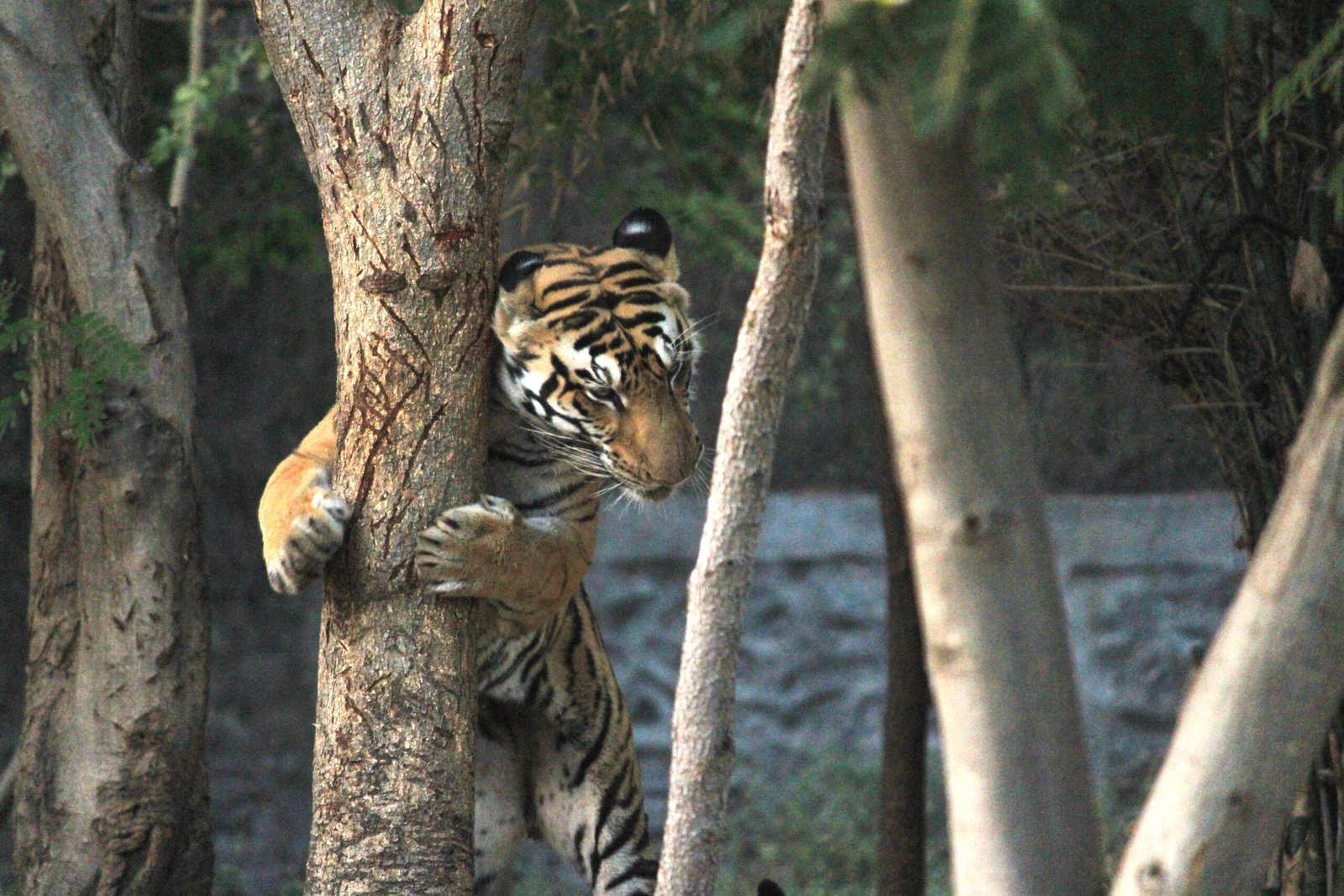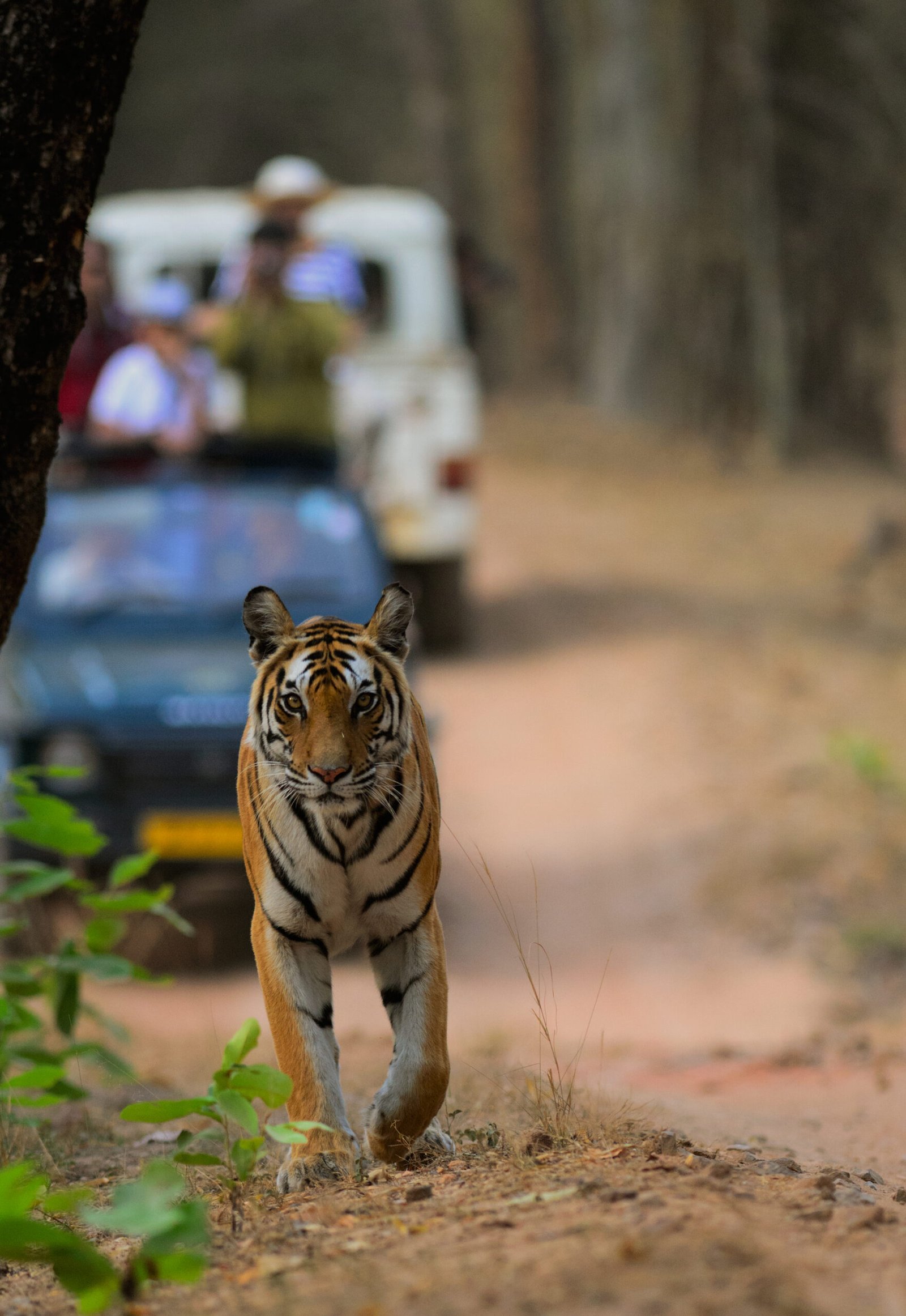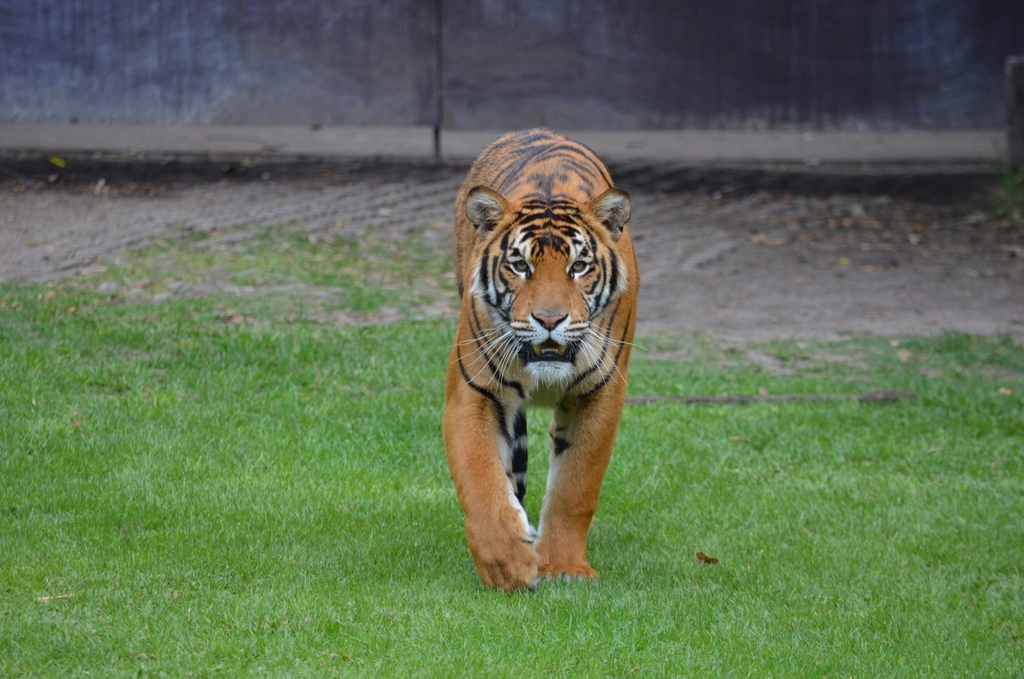You never forget the first time you sense a tiger nearby. The jungle suddenly hushes, every leaf and branch humming with possibility. Your heart pounds as you scan the dappled shadows, searching for a flash of stripes or a low, rumbling growl. Tracking a tiger isn’t just about following paw prints—it’s about tuning into a world where every sound, scent, and flicker matters. Tigers aren’t just big cats; they’re the silent rulers of their realm, and stepping into their world, even for a day, is like wandering into a living legend. This journey isn’t just awe-inspiring; it’s humbling and a little terrifying too. The wild feels different when you know a tiger might be watching, always a step ahead.
Mystery in the Morning Mist

Early mornings in tiger country are a study in patience and hope. The mist hangs low, swirling around ancient trees and tall grass, making every shadow look like it might move. It’s quiet—almost too quiet—and the air is crisp and thick with anticipation. As you walk, every crackle underfoot feels amplified, and you wonder if somewhere, unseen golden eyes are watching from the gloom. It’s thrilling and a little unnerving, knowing you’re on the tiger’s turf, where it’s the undisputed king. The silence is broken only by distant bird calls or the rustle of monkeys. In these precious moments, it’s easy to feel tiny—a guest in a world that belongs to the wild.
Paw Prints in the Sand

Finding a tiger’s paw print is like stumbling across a secret left just for you. The tracks are massive, bigger than your own hand, pressed deep into riverbank sand or the soft earth along a trail. You crouch down, tracing the shape with your fingers, imagining the sheer size of the animal that made them. It’s a quiet, humbling reminder of the tiger’s strength and weight. Sometimes, the prints are fresh enough to still hold the morning dew. In that moment, you realize the tiger could be close, hidden just out of sight. Each print tells a story—where the cat was heading, how fast it moved, even if it was alone or with cubs.
The Language of Alarm Calls

Jungle life has its own secret language, and when a tiger moves, the forest talks about it. You might hear the urgent bark of a spotted deer or the shrill scream of a langur monkey. These alarm calls act like sirens, warning everyone that a predator is near. It’s amazing how quickly the atmosphere changes—a flock of birds might take flight, and even the insects seem to hush. As a tracker, you learn to listen for these clues, letting the wild creatures guide you closer to the tiger’s path. It’s teamwork, in a way, even though you’re just a visitor, and the animals are fighting for survival.
Stripes in the Sunlight

There’s nothing quite like the heart-stopping moment when you finally glimpse a tiger’s stripes through the undergrowth. Sunlight dapples the forest floor, and suddenly, those iconic orange-and-black bands stand out against the green. Tigers are masters of camouflage, but when you spot one, every detail feels electric—the way its muscles ripple as it moves, how its tail flicks with quiet confidence. Even from a distance, the tiger’s beauty is breathtaking, almost unreal. You might catch yourself holding your breath, not wanting to break the spell. Tigers move with a grace that’s both powerful and delicate, a reminder of nature’s artistry.
The Scent Trail

Tigers mark their territory with a pungent, musky scent that lingers in the air. As you track, you’ll often catch whiffs of this wild perfume—sometimes sweet, sometimes sharp, always unforgettable. These scent marks are messages, warning other tigers to stay away and letting you know you’re deep in their world. It’s a little like reading invisible graffiti on the jungle walls. Following these trails, you start to understand how tigers communicate without ever saying a word. The scent is a reminder that the tiger’s presence is everywhere, even when you can’t see it. It’s both a thrill and a warning: you’re not alone here.
The Power of Patience

Tracking a tiger is a lesson in patience—maybe the ultimate test. There are long, quiet hours where nothing seems to happen, except the slow ticking of your own nerves. You sit, sweat trickling down your back, resisting the urge to fidget or talk. Every so often, a rustle or distant call jolts you into alertness, but more often than not, it’s just the wind. This waiting game can be frustrating, but it’s also oddly peaceful. You learn to slow down, to really become part of the landscape. It’s almost meditative, a rare chance to just be present and open to whatever the wild decides to reveal.
Listening for the Unseen

In tiger country, your ears become as important as your eyes. The forest is full of noises—some familiar, like bird songs, and others mysterious, like the distant snap of a twig or the soft padding of paws. When you’re tracking, every sound matters. Sometimes, the tiger gives itself away with a low growl or a cough, but more often, it’s the absence of sound that’s telling. Everything seems to hold its breath when a tiger is near. You start to hear the world differently, picking up subtleties you would usually miss. It’s a skill that makes you feel a little more like a wild animal yourself.
The Heat of the Day

As the sun climbs higher, the jungle changes character. The cool promise of morning fades, replaced by thick, sticky heat that clings to your skin. Tigers, too, slow down in this weather, often retreating to shady thickets or resting near waterholes. For trackers, the heat is exhausting but also a clue—where there’s water and shade, there might be a tiger. Sometimes you stumble across a spot where the grass is flattened and still warm, evidence of a recent nap. It’s a reminder that tigers are creatures of comfort too, and even the fiercest predator enjoys a lazy afternoon in the shade.
Following the Waterways

Tigers are surprisingly fond of water. They’ll often be found lounging by streams or ponds, especially when the weather’s hot. Following these waterways can be a smart strategy for a tracker. If you’re lucky, you might see wet paw prints leading from the riverbank or hear the splash of a tiger cooling off. Sometimes, a tiger will even swim across to reach new hunting grounds. There’s something magical about knowing you share this moment with an animal that’s both feared and playful, wild but oddly relatable. It’s a side of tigers you don’t often see in stories—one that brings them closer to us.
The Art of Camouflage

Tigers are masters of disappearing in plain sight. Their stripes aren’t just beautiful—they’re the perfect disguise, breaking up their outline among the dappled sunlight and tangled undergrowth. More than once, you might walk right past a tiger without even knowing it. That realization sends a chill down your spine. It’s humbling to think that such a massive animal can melt into the landscape so completely. This camouflage is a gift from evolution, making the tiger both predator and phantom. It’s a reminder that the wild is filled with secrets, and sometimes, the most extraordinary things are hiding right in front of you.
When the Jungle Holds Its Breath

There are moments in the jungle when everything suddenly goes still. No birds sing, no monkeys chatter—the world seems to pause. That’s when you know a tiger is close. The tension is almost electric, crackling in the air. You feel it in your bones, a primal sense that something powerful is near. It’s equal parts awe and fear—a cocktail that makes your heart race. The silence is deafening, and you find yourself holding your own breath, waiting for a sign. When the jungle finally exhales, whether with a distant roar or the flutter of wings, it’s like waking from a dream.
The Majesty of a Roar

Hearing a tiger’s roar for the first time is nothing short of breathtaking. It’s not just loud—it’s deep and resonant, rolling through the jungle like thunder. You might feel it more than hear it, a vibration in your chest that lingers long after the sound fades. A roar can travel for miles, a declaration of territory and power. For a moment, you’re reminded just how tiny you are in the grand scheme of things. It’s a sound that commands respect, both from animals and humans alike. Even if you never see the tiger, that roar stays with you—a wild song echoing in your memory.
Stories Written in Scratches

Tigers leave their mark on the land in more ways than one. Sometimes, you’ll find deep scratches on tree trunks, made by powerful claws. These marks are more than decoration—they’re messages, boundaries drawn for other tigers and reminders of who rules this patch of jungle. Running your fingers over these grooves, you can feel the strength it takes to carve them. It’s a little like reading a diary written in wood. Each scratch tells a story of presence, dominance, and survival. It’s a way to connect with the unseen tiger, to touch the legacy it leaves behind.
Solitude of the Stripes

Tigers are famously solitary creatures. Unlike lions, who live in prides, tigers prefer their own company, roaming vast territories alone. This solitude makes every encounter feel rare and precious. There’s a lonely beauty to the tiger’s life—a freedom that comes with challenges, like finding enough food and avoiding rivals. For trackers, this means the search is often long and quiet, filled with uncertainty. But it’s also inspiring: the idea of a big cat carving out its own path, surviving by its wits and strength. The tiger’s loneliness is a reminder of the wild’s untamed spirit.
When Shadows Move

The tiger is a creature of shadows, slipping through the dusk with barely a sound. As daylight fades, the forest comes alive in new ways. You might catch a glimpse of stripes gliding between trees, so silent it almost feels supernatural. In these twilight hours, your senses sharpen. Every movement, every rustle takes on new meaning. Tracking a tiger at dusk is both a challenge and a privilege—it’s when the jungle truly belongs to its wildest inhabitants. There’s a thrill in knowing you’re sharing the evening with a legend, even if you only catch a fleeting glimpse before darkness claims the forest.
A Cub’s First Steps

Every so often, you get lucky enough to spot tiger cubs. Seeing a mother lead her young through the jungle is pure magic. The cubs are awkward and playful, tumbling over each other as they learn the ways of the wild. Their mother is fiercely protective, never straying far. Watching this little family, you’re reminded that even the mightiest predator starts life as a vulnerable, clumsy bundle of fur. It’s a scene full of hope and tenderness—a symbol of the tiger’s future. These moments are precious, a reminder of what’s at stake in the fight to save these animals from extinction.
The Thrill of the Hunt

Witnessing a tiger on the hunt is an unforgettable experience. The air crackles with tension as the big cat moves with calculated silence, every muscle poised. You can almost feel the focus and patience required—waiting for the perfect moment to strike. Sometimes, the hunt ends in a burst of speed, a blur of orange and black as the tiger chases its prey. Other times, it’s a lesson in humility, as the prey escapes and the tiger fades back into the trees. The hunt is a raw, honest display of survival, a dance between predator and prey that has played out for millennia.
The Bond with Rangers

Behind every successful tiger tracking adventure is a team of dedicated forest rangers. These men and women know the jungle like the back of their hand, reading signs most people would miss. Their respect for the tigers is palpable—they speak of the big cats with a mix of awe and affection. For trackers, learning from rangers is like being let in on ancient secrets. The bond that forms while searching together for signs of the elusive cat is deep and genuine. Rangers are the unsung heroes of tiger conservation, working tirelessly to protect both the animals and the people who come to see them.
The Weight of Conservation

Tracking tigers isn’t just about adventure—it’s a stark reminder of how fragile their world is. Poaching, habitat loss, and human-wildlife conflict threaten these magnificent animals every day. As you walk the trails and listen to the rangers’ stories, the reality hits home: every tiger sighting is a small miracle. There’s hope in the efforts being made—protected reserves, anti-poaching patrols, and education programs—but the fight is far from over. Tracking tigers connects you to the bigger picture, making the importance of conservation personal and urgent. It’s a call to action, echoing in the wild places where tigers still roam.
The Unexpected Companions

Tiger tracking often introduces you to other wild residents of the jungle. You might cross paths with elephants, hear the chatter of macaques, or spot a lazy python basking in the sun. Each encounter adds to the tapestry of the wild, reminding you that the tiger is just one thread in a much larger web. These animals share the same forests and rivers, their lives intertwined in ways both obvious and mysterious. It’s a humbling experience, one that makes you appreciate the delicate balance of nature. The jungle is alive with stories, and the tiger’s is just one among many.
Footprints in the Memory

Long after you leave the jungle, the experience of tracking a tiger lingers. You find yourself remembering the thrill of discovery, the quiet moments of waiting, the heart-pounding excitement of a close encounter. Even the smallest details—the scent of earth after rain, the distant call of a peacock—become precious memories. Tracking a tiger changes the way you see the world. It teaches you to pay attention, to respect the unknown, and to cherish wildness wherever you find it. These memories are footprints that never fade, reminders of a world that still holds wonder.
The Pulse of the Wild

There’s a rhythm to the jungle that you can feel when tracking tigers. It’s in the pulse of your own heartbeat, the rustle of leaves, the distant rumble of thunder. The wild is alive—a living, breathing entity that welcomes and challenges you in equal measure. Following a tiger’s trail, you become part of this rhythm, moving in time with the hidden life around you. It’s a feeling that’s hard to describe, a mix of excitement, respect, and belonging. For a brief moment, you’re not just an observer—you’re part of the story, woven into the fabric of the wild.
The Beauty of the Unseen

Sometimes, you never actually see the tiger. You might spend days following tracks, listening for calls, and waiting in silence—only to return home with little more than stories and a few blurry photos. And yet, the magic of tracking isn’t always about the final sighting. It’s about the journey, the anticipation, and the connection to something bigger than yourself. Knowing the tiger is out there, unseen but surely present, brings its own kind of satisfaction. The beauty of the unseen is a lesson in humility and wonder—a reminder that the wild doesn’t exist just for us, but in spite of us.
The Hope for Tomorrow

Every tiger tracked, every paw print found, is a sign of hope for the future. These moments prove that, despite all odds, wild tigers still roam the forests. Conservation efforts, though challenging, are making a difference. Each cub born, each territory reclaimed, is a small victory. Tracking tigers becomes more than a personal adventure—it’s a symbol of resilience and renewal. The hope is that with enough care and determination, future generations will also feel the rush of seeing stripes in the wild. It’s a shared dream, one that binds all who love the wild in a quiet, powerful way.
Conclusion

There’s something profoundly moving about tracking a tiger in the wild. It’s a journey that stirs the soul and sharpens the senses, leaving you forever changed. Whether you glimpse a flash of stripes or simply feel the weight of the jungle’s silence, the experience is a reminder of the beauty and mystery that still exists in our world. Tigers are more than just symbols of power—they are living testaments to the resilience and wonder of nature. The memory of their presence lingers long after you leave, a call to cherish and protect the wild places where magic still happens. Would you dare to follow the stripes?

Suhail Ahmed is a passionate digital professional and nature enthusiast with over 8 years of experience in content strategy, SEO, web development, and digital operations. Alongside his freelance journey, Suhail actively contributes to nature and wildlife platforms like Feline Fam, where he channels his curiosity for the Feline into engaging, educational storytelling.
With a strong background in managing digital ecosystems — from ecommerce stores and WordPress websites to social media and automation — Suhail merges technical precision with creative insight. His content reflects a rare balance: SEO-friendly yet deeply human, data-informed yet emotionally resonant.
Driven by a love for discovery and storytelling, Suhail believes in using digital platforms to amplify causes that matter — especially those protecting Earth’s biodiversity and inspiring sustainable living. Whether he’s managing online projects or crafting wildlife content, his goal remains the same: to inform, inspire, and leave a positive digital footprint.






